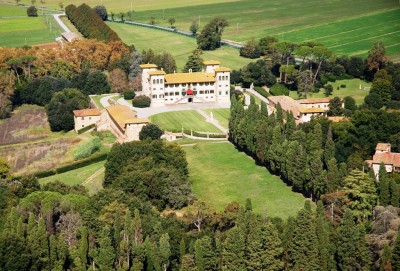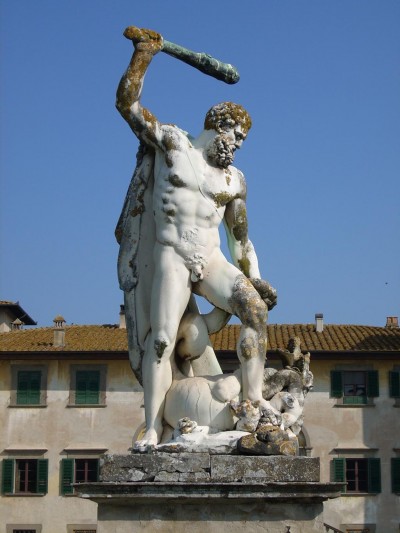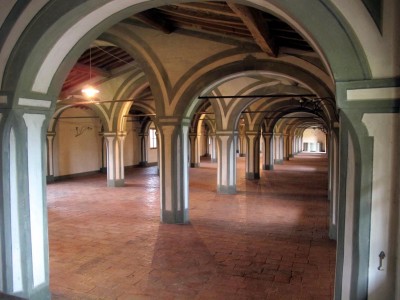Camugliano is one of the most important estates in Tuscany, and today the Tenuta still represents an example of one of those very rare places where every element has been preserved and handed down with an eye to continuity and passion.
Contact the abode
Camugliano is one of the most important estates in Tuscany, and today the Tenuta still represents an example of one of those very rare places where every element has been preserved and handed down with an eye to continuity and passion. Its centuries-old history is intertwined with the vicissitudes of the Niccolini family, who have owned it since 1637. It is impossible for anyone who visits the park and buildings adjacent to the Medici villa not to perceive the charm of bygone times and the strong connection to the land, which demonstrates the highest expression of the intertwining of life on a villa and farming traditions.
THE HISTORY OF TENUTA DI CAMUGLIANO
According to tradition, the Camugliano villa was founded by Duke Alessandro de' Medici some time after 1532. It later passed to the Salviati and Gondi families, then to Marquis Matteo Botti, chamberlain to the Grand Duke. After the latter's bankruptcy, it was acquired by the Medici bank as noted in their ‘Scrittoio delle Possessioni’ or Royal Possession’s Office. From the inventory of that time, it is clear that the entire property was in very poor condition, and the building itself was not a sound, solid structure. In 1634, negotiations were opened between the Scrittoio and Filippo Niccolini, a Florentine patrician who was interested in purchasing the estate. He concluded the deal for the sum of 50,000 scudi on 23 September, 1634. Subsequently, Niccolini was granted the title of Marquis of Ponsacco and Camugliano by the Grand Duke, in addition to another marquisate he already possessed. He immediately began extensive renovation work on the Villa, as called for by his surveyors, and made major improvements to the overall state of the entire estate by cultivating more crops, draining the fields and planting vineyards.
The current appearance of the Villa, attributed to Marquis Filippo and designed by architects from the Florentine area, was inspired by similar interventions carried out on other Medici villas of the late 16th century. It is presumed that masonry work was conducted on the walls, whose thinness had been pointed out by the experts, along with the construction of three of the four corner towers ex-novo and the reduction of the pre-existing tower to their form. The extensive area in front of the southern façade was enclosed by two independent wings: the granary and stables to the west, and the farmhouse and wine cellar to the east.
The foundations were fortified with powerful containment walls. The loggia resembles the one built by Filippo in 1655 in the inner courtyard of his residence on Via dei Servi in Florence, which was the period when work was also started on the magnificent chapel in the Basilica of Santa Croce. The private chapel dedicated to St. Philip is accessed on the ground floor, via the long central hallway that runs the length of the entire building, while on the first floor, the vault of the impressive central hall was frescoed by Angelo Michele Colonna. The arrangement of the park, including the creation of cypress avenues leading to features including the Church of San Frediano, dates back to 1640.
After Filippo's death in 1666, it was during the marquisates of Giovanluca (died in 1752) and Lorenzo (died in 1795) that significant improvements were made to the various farm buildings on the estate. The wine cellars were expanded, the loggia of the villa was closed off and the southern lawn was enclosed by a wall on which marble busts were placed, at the centre of which a statue of Hercules by Giovanni Bandini (known as Giovanni dall'Opera) was installed. These works all came from the famous collection of sculptures at the Palazzo on Via dei Servi after it was sold. Stone coats of arms in ‘pietra serena’ sandstone of the Niccolini family and the families that were united with it through marriage were also affixed to the outer corner of each tower. In the following century, another Lorenzo (died in 1868) created the English garden and commissioned a meticulous survey of the entire estate. Such was the fame of this prestigious residence that Grand Duke Leopold requested hospitality for Pope Pius IX in 1857, who stayed here during one of his trips to Tuscany.
FACILITIES AND SERVICES: ACCOMMODATION, WEDDINGS AND PRIVATE EVENTS IN TUSCANY
Architectural and naturalistic themed guided tours of Tenuta di Camugliano’s villa and park estate are available, as well as truffle-hunting and tasting typical produce from the Tenuta by enjoying the excellent Tuscan cuisine served at the Locanda.
Our guides will tell you about the history of the area, the Villa and the Niccolini family, accompanying you on two fascinating routes that bear witness to the harmony between nature and ancient buildings, exemplifying the incomparable harmony and self-sufficiency of times gone by. The naturalistic route will consist of a stroll through the vegetable garden, the English garden, the park with its avenues and the woodland, discovering centuries-old plants and characteristic sights such as the buttery and the icehouse. In terms of the architecture, the route will highlight the architectonic wonders all over the Medici villa and overlooking the extensive lawns: the granary, the stables, the wine cellars, the carpenter's workshop, the spinning-mill and the underground cellars.
Locanda Camugliano: this former farmhouse, located in the heart of the estate, near the Church of San Frediano, has been converted into a restaurant with a charming atmosphere of yesteryear. We recommend you end your visit here, enjoying a snack or tasting one of our traditional dishes, cooked using the Tenuta's organic products.
You can also organize a Truffle Hunt at the Tenuta di Camugliano. The centuries-old trees in the park makes it possible for visitors to search for this precious and rare tuber during the truffle-hunting season.
The integrity of the estate, which has been managed in a completely organic manner for decades, and the nature of the land provide the best conditions for this unique and exclusive hunt.
It is also possible to taste and purchase already harvested truffles.


